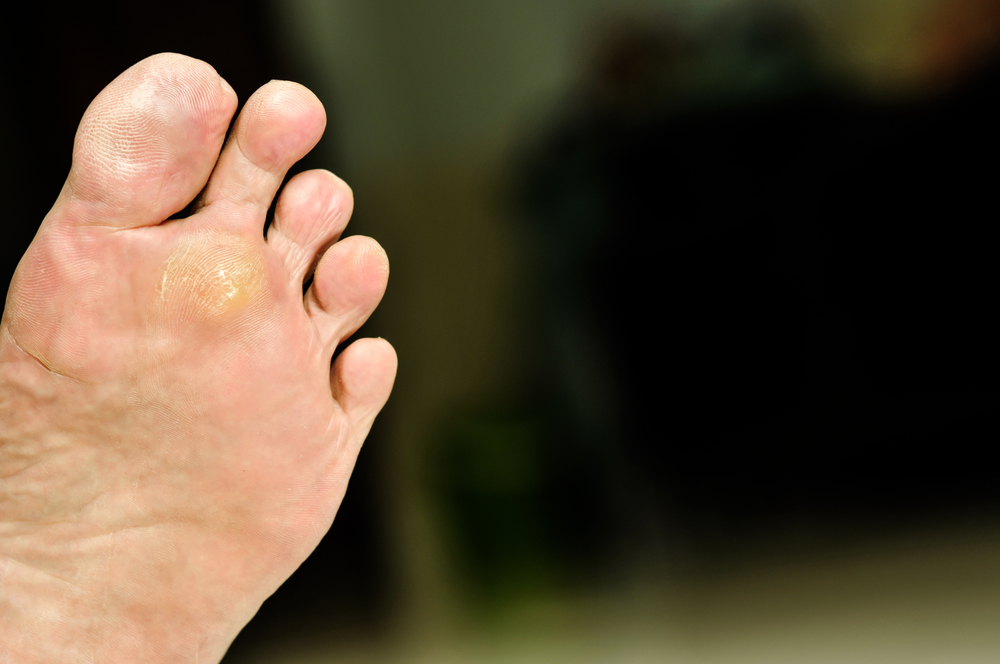Items filtered by date: December 2022
Teens and Plantar Warts

A wart is a growth on the skin caused by over 100 types of the human papillomavirus (HPV). The virus causes a thickening of the top skin layer. Plantar warts occur on the soles of the feet. These can look and feel like calluses. Anyone can get warts, but children aged 12 to 16 and those who have HIV, organ transplants, or are on chemotherapy are at the highest risk for them. Warts are often acquired from a person that has the virus. While not highly contagious, the virus can enter the skin through small cuts or cracks. It is suggested that towels and other intimate objects not be shared, and shoes be worn in public places. Warts are typically harmless and painless, but plantar warts might feel tender when walked on. These warts can be small, or they can grow to cover most of the sole of the foot. They often go away on their own, but this can take up to two years. If your teen has a plantar wart that is bothersome or interferes with their normal daily activities, please consult a podiatrist for treatment options.
Plantar warts can be very uncomfortable. If you need your feet checked, contact Darren Day, DPM from Hawaii. Our doctor will assist you with all of your foot and ankle needs.
About Plantar Warts
Plantar warts are the result of HPV, or human papillomavirus, getting into open wounds on the feet. They are mostly found on the heels or balls of the feet.
While plantar warts are generally harmless, those experiencing excessive pain or those suffering from diabetes or a compromised immune system require immediate medical care. Plantar warts are easily diagnosed, usually through scraping off a bit of rough skin or by getting a biopsy.
Symptoms
- Lesions on the bottom of your feet, usually rough and grainy
- Hard or thick callused spots
- Wart seeds, which are small clotted blood vessels that look like little black spots
- Pain, discomfort, or tenderness of your feet when walking or standing
Treatment
- Freezing
- Electric tool removal
- Laser Treatment
- Topical Creams (prescription only)
- Over-the-counter medications
To help prevent developing plantar warts, avoid walking barefoot over abrasive surfaces that can cause cuts or wounds for HPV to get into. Avoiding direct contact with other warts, as well as not picking or rubbing existing warts, can help prevent the further spread of plantar warts. However, if you think you have developed plantar warts, speak to your podiatrist. He or she can diagnose the warts on your feet and recommend the appropriate treatment options.
If you have any questions please feel free to contact our offices located in Honolulu and Kahuku, HI . We offer the newest diagnostic and treatment technologies for all your foot and ankle needs.
Symptoms of Poor Circulation

A common sign of poor circulation is cold feet. Additionally, some patients feel a numbing or tingling sensation, and may have hair loss on the legs. Poor circulation can cause cracked heels, wounds to heal slower, and toenails may become weakened. This condition may be a symptom of underlying medical conditions, including diabetes, arteriosclerosis, or peripheral artery disease, and specific risk factors may precede these conditions. These can consist of smoking, having high blood pressure or cholesterol, and becoming physically inactive. Research has shown that poor circulation may be improved by having frequent massages, wearing compression socks or stockings, and practicing relaxation techniques. Poor circulation of the feet can cause difficulty in completing daily activities. If you are afflicted with this ailment, please consult a podiatrist for an effective diagnosis and treatment program.
While poor circulation itself isn’t a condition; it is a symptom of another underlying health condition you may have. If you have any concerns with poor circulation in your feet contact Darren Day, DPM of Hawaii. Our doctor will treat your foot and ankle needs.
Poor Circulation in the Feet
Peripheral artery disease (PAD) can potentially lead to poor circulation in the lower extremities. PAD is a condition that causes the blood vessels and arteries to narrow. In a linked condition called atherosclerosis, the arteries stiffen up due to a buildup of plaque in the arteries and blood vessels. These two conditions can cause a decrease in the amount of blood that flows to your extremities, therefore resulting in pain.
Symptoms
Some of the most common symptoms of poor circulation are:
- Numbness
- Tingling
- Throbbing or stinging pain in limbs
- Pain
- Muscle Cramps
Treatment for poor circulation often depends on the underlying condition that causes it. Methods for treatment may include insulin for diabetes, special exercise programs, surgery for varicose veins, or compression socks for swollen legs.
As always, see a podiatrist as he or she will assist in finding a regimen that suits you. A podiatrist can also prescribe you any needed medication.
If you have any questions, please feel free to contact our offices located in Honolulu and Kahuku, HI . We offer the newest diagnostic and treatment technologies for all your foot care needs.
Kinds of Running Shoes

If you are a runner, then it is imperative that you select running shoes that are providing your feet with the kind of support that they deserve and need. There are several different broad categories of different running shoes that you might consider buying depending on your precise needs. For example, one main type of running shoe is known as a neutral running shoe. This shoe is primarily meant to absorb shock and feature arches that have medium height. Additionally, another kind of running shoe is known as a stability running shoe. These shoes can be particularly helpful to individuals who are prone to having their feet roll inward and outward during runs. Lastly, there are cushioned running shoes that are particularly beneficial to individuals that strike their heels forcefully when running. Individuals with high heels also can benefit from wearing this kind of shoe. Contact a podiatrist today for more information about different types of running shoes.
If you are a runner, wearing the right running shoe is essential. For more information, contact Darren Day, DPM from Hawaii. Our doctor can provide the care you need to keep you pain-free and on your feet.
Choosing the Right Running Shoe for Your Foot Type
To increase performance and avoid the risk of injury, it is important to choose the right running shoe based on your foot type. The general design of running shoes revolves around pronation, which is how the ankle rolls from outside to inside when the foot strikes the ground.
- Neutral runners are able to choose from a wide variety of shoes, including minimalist shoes or even going barefoot.
- Runners who overpronate, or experience an over-abundance of ankle rolling, should choose shoes that provide extra motion control and stability.
- Runners who underpronate, or supinate, have feet that have high arches and lack flexibility, preventing shock absorption. They require shoes with more flexibility and cushion.
If you have any questions please feel free to contact our offices located in Honolulu and Kahuku, HI . We offer the newest diagnostic and treatment technologies for all your foot and ankle needs.
Wounds That Don't Heal Need to Be Checked
Common Signs of Toenail Fungus

The most common type of nail disorder is known as onychomycosis, which is the medical term for toenail fungus. It can be an unsightly foot condition, and many people may choose to wear shoes that have a closed toe to conceal the toenails. The noticeable symptoms that most patients experience consist of yellowed toenails which have become thick, and in severe cases, may fall off. There may also be black or white spots at the bottom of the nail, which may spread to the entire surface. Toenail fungus is considered to be contagious, and is often found in warm and moist environments. These can include public swimming pools, shower room floors, and locker rooms. It is strongly advised that appropriate shoes such as flip flops or water shoes be worn while in these types of areas, which may help to stop the spread of toenail fungus. Additionally, it is beneficial to wear shoes and socks that are made of breathable materials, and use disinfectants and antifungal powder inside the shoes to help the feet feel better. If you see the beginning signs of toenails fungus, it is suggested that you consult with a podiatrist who can offer you the correct treatment methods.
If left untreated, toenail fungus may spread to other toenails, skin, or even fingernails. If you suspect you have toenail fungus it is important to seek treatment right away. For more information about treatment, contact Darren Day, DPM of Hawaii. Our doctor can provide the care you need to keep you pain-free and on your feet.
Symptoms
- Warped or oddly shaped nails
- Yellowish nails
- Loose/separated nail
- Buildup of bits and pieces of nail fragments under the nail
- Brittle, broken, thickened nail
Treatment
If self-care strategies and over-the-counter medications does not help your fungus, your podiatrist may give you a prescription drug instead. Even if you find relief from your toenail fungus symptoms, you may experience a repeat infection in the future.
Prevention
In order to prevent getting toenail fungus in the future, you should always make sure to wash your feet with soap and water. After washing, it is important to dry your feet thoroughly especially in between the toes. When trimming your toenails, be sure to trim straight across instead of in a rounded shape. It is crucial not to cover up discolored nails with nail polish because that will prevent your nail from being able to “breathe”.
In some cases, surgical procedure may be needed to remove the toenail fungus. Consult with your podiatrist about the best treatment options for your case of toenail fungus.
If you have any questions, please feel free to contact our offices located in Honolulu and Kahuku, HI . We offer the newest diagnostic and treatment technologies for all your foot care needs.






